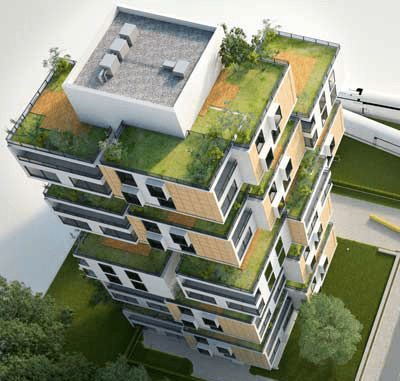Prabhat Sharma
Indian Institute of Technology Bombay, Mumbai, India
Corresponding Author: 19i170005@iitb.ac.in
Priyanka Kumawat
National Institute of Technology, Jaipur, India
Anupama Kowli
Indian Institute of Technology Bombay, Mumbai, India
Cite this article
Highlights
- Thermal performance of wall panels made up of bagasse was analyzed.
- Lower thermal conductivity compared with the traditional brick.
- 28 % decrease in the thermal cooling load of the house.
- A 16.4 % increase in the thermal comfort hours is obtained.
Abstract
Using brick-concrete for building envelope is a common practice in India. These envelopes have high heat gains and experience large embodied energy. Agro-waste panels made up of sugarcane waste can significantly reduce cooling load for new construction due to its better u-value and also reduce carbon emission since it is produced from sugarcane waste, i.e., bagasse. A double storey naturally ventilated building has been simulated for Mumbai climatic conditions to understand the performance of agro-waste materials. The total cooling load and temperature profile for a year have been simulated using EnergyPlus software. Thermal comfort hours are calculated using the India model for adaptive comfort (IMAC) band to show the potential of the agro-based panel. The thermal cooling load of the simulated building incorporated with an agro-waste panel decreased by 28 % as compared to the brick-concrete envelope. There is a 16.4 % increase in annual thermal comfort hours compared to brick-concrete envelope.
References
- IEA (2020), Key World Energy Statistics 2020, IEA, Paris https://www.iea.org/reports/key-world-energy-statistics-2020
- T. Ramesh, R. Prakash, and K. Shukla, “Life cycle energy analysis of buildings: An overview,” Energy and buildings, vol. 42, pp. 1592-1600, 2010. https://doi.org/10.1016/j.enbuild.2010.05.007
- G. Kang, T. Kim, W. Y. Kim, H. Cho, and I. K. Kang, “Statistical analysis of embodied carbon emission for building construction,” Energy and Buildings, vol. 105, pp. 326-333, October 2015. https://doi.org/10.1016/j.enbuild.2015.07.058
- F. You, D. Hu, H. Zhang, Z. Guo, Y. Zhao, B. Wang, and Y. Yuan, “Carbon emissions in the life cycle of urban building system in China-A case study of residential buildings,” Ecological Complexity, vol. 8, pp. 201-212, June 2011. https://doi.org/10.1016/j.ecocom.2011.02.003
- K. Jana, and S. De., “Environmental impact of an agro-waste based polygeneration without and with CO2 storage: life cycle assessment approach,” Bioresource Technology, vol. 216, pp. 931-940, September 2016. https://doi.org/10.1016/j.biortech.2016.06.039
- M. V. Madurwar, R. V. Ralegaonkar, and S. A. Mandavgane, “Application of agro-waste for sustainable construction materials: A review,” Construction and Building materials, vol. 38, pp. 872-878, Janurary 2013. https://doi.org/10.1016/j.conbuildmat.2012.09.011
- B. Boschma, and W. Kwant, “Rice straw and wheat straw: potential feedstocks for the biobased economy,” NL Agency Ministry of Economic Affairs, pp. 6-30, 2013.
- C. A. O. Guoliang, X. Zhang, G. O. N. G. Sunling, and F. Zheng, “Investigation on emission factors of particulate matter and gaseous pollutants from crop residue burning,” Journal of Environmental Sciences, vol. 20, pp. 50-55, 2008. https://doi.org/10.1016/S1001-0742(08)60007-8
- K. Doost-Hoseini, H. R. Taghiyari, and A. Elyasi, “Correlation between sound absorption coefficients with physical and mechanical properties of insulation boards made from sugar cane bagasse,” Composites Part B: Engineering, vol. 58, pp. 10-15, 2014. https://doi.org/10.1016/j.compositesb.2013.10.011
- S. Mehrzad, E. Taban, P. Soltani, S. E. Samaei, and A. Khavanin, “Sugarcane bagasse waste fibers as novel thermal insulation and sound-absorbing materials for application in sustainable buildings,” Building and Environment, vol. 211, pp. 108753, March 2022. https://doi.org/10.1016/j.buildenv.2022.108753
- E. Chabi, V. Doko, S. P. Hounkpè, and E. C. Adjovi, “Study of cement composites on addition of rice husk,” Case Studies in Construction Materials, vol. 12 pp. e00345, June 2020. https://doi.org/10.1016/j.cscm.2020.e00345
- J. Wang, Y. Zuo, J. Xiao, P. Li, and Y. Wu, “Construction of compatible interface of straw/magnesia lightweight materials by alkali treatment,” Construction and Building Materials, vol. 228, pp. 116712, December 2019. https://doi.org/10.1016/j.conbuildmat.2019.116712
- J. Li, X. Meng, Y. Gao, W. Mao, T. Luo and L. Zhang, “Effect of the insulation materials filling on the thermal performance of sintered hollow bricks,” Case studies in thermal engineering, vol. 11, pp. 62-70, March 2018. https://doi.org/10.1016/j.csite.2017.12.007
- R. Ahmadi, B. Souro and M. Ebrahimi, “Evaluation of wheat straw to insulate fired clay hollow bricks as a construction material,” Journal of Cleaner Production, vol. 254, pp. 120043, May 2020. https://doi.org/10.1016/j.jclepro.2020.120043
- W. Hu, Y. Xia, F. Li, H. Yu, C. Hou, and X. Meng, “Effect of the filling position and filling rate of the insulation material on the insulation performance of the hollow block,” Case Studies in Thermal Engineering, vol. 26, pp. 101023, August 2021. https://doi.org/10.1016/j.csite.2021.101023
- P. C. Tabares-Velasco, C. Christensen, and M. Bianchi, “Verification and validation of EnergyPlus phase change material model for opaques wall assemblies,” Building and Environment, vol. 54, pp. 186-196, August 2012. https://doi.org/10.1016/j.buildenv.2012.02.019
- S. El Ahmar, F. Battista, and and A. Fioravanti, “). Simulation of the thermal performance of a geometrically complex Double-Skin Facade for hot climates: EnergyPlus vs. OpenFOAM,” Building Simulation, vol. 12. pp. 781-795, October 2019. https://doi.org/10.1007/s12273-019-0530-8
- S. Yu, Y. Cui, X. Xu, and G. Feng, “Impact of civil envelope on energy consumption based on EnergyPlus,” Procedia Engineering, vol. 121, pp. 1528-1534, Janurary 2015. https://doi.org/10.1016/j.proeng.2015.09.130
- J. S. Carlos, “Simulation assessment of living wall thermal performance in winter in the climate of Portugal,” Building Simulation, vol. 8, pp. 311, Februry 2015. https://doi.org/10.1007/s12273-014-0187-2
- Team SHUNYA IIT Bombay, U.S. department of energy solar decathlon build challenge 2023 https://www.solardecathlon.gov/event/competitionteam-indian-institute-of-technology-bombay.html

 Bishal Thapa
Bishal Thapa





 Fred Sherman
Fred Sherman Sumedha Malaviya
Sumedha Malaviya Satish Kumar
Satish Kumar












 The three main global energy concerns of providing access to modern energy, enhancing the security of the energy supply, and minimising the impact of energy systems on the climate have an impact on both national and international energy governance. To develop solutions that address the many facets of these difficulties, however, a variety of actors and stakeholders must be included due to the complexity of the energy challenges.
The three main global energy concerns of providing access to modern energy, enhancing the security of the energy supply, and minimising the impact of energy systems on the climate have an impact on both national and international energy governance. To develop solutions that address the many facets of these difficulties, however, a variety of actors and stakeholders must be included due to the complexity of the energy challenges. Cities are responsible for more than 70% of the world’s energy consumption and 40% to 50% of its greenhouse gas emissions. Managing increasing urbanisation is a challenge, and nations must deal with the effects it will have on the environment in terms of energy and climate.
Cities are responsible for more than 70% of the world’s energy consumption and 40% to 50% of its greenhouse gas emissions. Managing increasing urbanisation is a challenge, and nations must deal with the effects it will have on the environment in terms of energy and climate. Our transition to a future with lower carbon emissions depends heavily on buildings. They are our places of residence, rest, and employment; they also account for around one-third of the world’s greenhouse gas emissions and nearly 40% of the world’s energy usage.
Our transition to a future with lower carbon emissions depends heavily on buildings. They are our places of residence, rest, and employment; they also account for around one-third of the world’s greenhouse gas emissions and nearly 40% of the world’s energy usage.